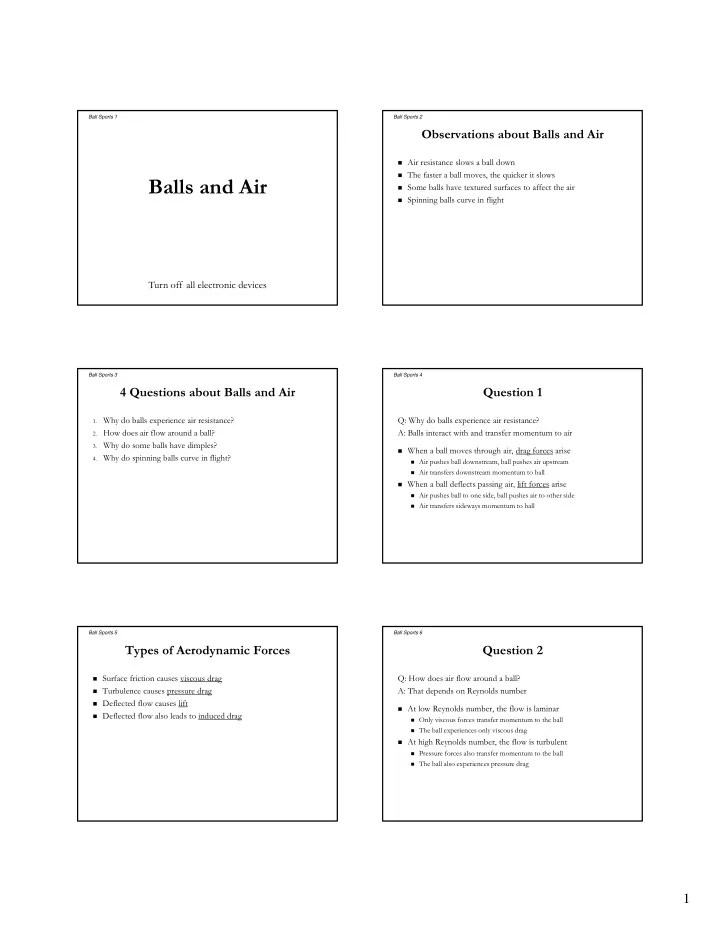

Ball Sports 1 Ball Sports 2 Observations about Balls and Air Air resistance slows a ball down The faster a ball moves, the quicker it slows Balls and Air Some balls have textured surfaces to affect the air Spinning balls curve in flight Turn off all electronic devices Ball Sports 3 Ball Sports 4 4 Questions about Balls and Air Question 1 1. Why do balls experience air resistance? Q: Why do balls experience air resistance? 2. How does air flow around a ball? A: Balls interact with and transfer momentum to air 3. Why do some balls have dimples? When a ball moves through air, drag forces arise 4. Why do spinning balls curve in flight? Air pushes ball downstream, ball pushes air upstream Air transfers downstream momentum to ball When a ball deflects passing air, lift forces arise Air pushes ball to one side, ball pushes air to other side Air transfers sideways momentum to ball Ball Sports 5 Ball Sports 6 Types of Aerodynamic Forces Question 2 Surface friction causes viscous drag Q: How does air flow around a ball? Turbulence causes pressure drag A: That depends on Reynolds number Deflected flow causes lift At low Reynolds number, the flow is laminar Deflected flow also leads to induced drag Only viscous forces transfer momentum to the ball The ball experiences only viscous drag At high Reynolds number, the flow is turbulent Pressure forces also transfer momentum to the ball The ball also experiences pressure drag 1
Ball Sports 7 Ball Sports 8 Laminar Flow around a Ball The Onset of Turbulence Air bends away from ball’s front Air flowing into the rising pressure behind ball At front: high pressure, slow flow accelerates backward (decelerates) Air bends toward ball’s sides and converts kinetic energy into pressure potential. Air flowing nearest the ball’s surface At side: low pressure, fast flow Air bends away from ball’s back also experiences viscous drag forces and converts kinetic energy into thermal energy. At back: high pressure, slow flow If it runs out of total energy, it stops or “stalls” Pressures on opposite sides balance perfectly If air nearest the ball stalls, turbulence ensues Ball experiences only viscous drag Ball Sports 9 Ball Sports 10 Turbulent Flow around Slow Ball Question 3 Air flowing near ball’s surface Q: Why do some balls have dimples? stalls beyond ball’s sides A: To produce a turbulent boundary layer and peels main air flow off of ball. Air affected by ball’s surface is the boundary layer Big wake forms behind ball Reynolds # <100,000: laminar boundary layer Since wake pressure is ambient, Nearest sublayer is slowed relentlessly by viscous drag ball experiences unbalanced pressures. Reynolds # >100,000: turbulent boundary layer Ball experiences a large pressure drag force Sublayers tumble and interchange; they help each other Boundary layer penetrates deeper into rising pressure Ball Sports 11 Ball Sports 12 Turbulent Flow Around Fast Ball Tripping the Boundary Layer Air flowing near ball’s surface To reduce pressure drag, some balls have dimples stalls beyond ball’s sides Dimples “trips” the boundary layer and peels main air flow off of ball. Cause boundary layer to become turbulent. Boundary layer is turbulent Turbulent boundary layer resists peeling better Ball’s main airflow forms smaller turbulent wake. and retains total energy farther, Example: Golf balls so it resists peeling better. Small wake forms behind ball Ball experiences a small pressure drag force 2
Ball Sports 13 Ball Sports 14 Question 4 Spinning Balls, Magnus Force Q: Why do spinning balls curve in flight? Turning surface pushes/pulls on the air flow A: They experience two aerodynamic lift forces Air on one side makes long bend toward ball Air on other side makes shorter bend away from ball Laminar effect: Magnus force Pressures are unbalanced Turning surface pushes/pulls on the air flow The overall air flow is deflected Air on one side makes longer bend toward the ball Ball pushes air to one side Turbulent effect: Wake deflection force Air pushes ball to other side Turning surface alters point of flow separation Ball feels Magnus force Flow separation and wake are asymmetric Ball Sports 15 Ball Sports 16 Spinning Balls, Wake Force Summary about Balls and Air Turning surface alters point of flow separation Balls in air experience aerodynamic forces Flow separation is delayed on one side Downstream forces are drag forces and hastened on the other side, Sideways pressure forces are lift forces so wake is asymmetric Moving particles experience viscous drag forces The overall air flow is deflected Moving balls experience pressure drag forces Ball pushes air to one side Spinning balls experience Magnus and wake deflection lift forces Air pushes ball to other side Ball feels wake deflection force 3
Recommend
More recommend